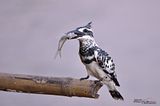Though Common Kingfisher (Alcedo atthis) can be seen year round in Japan, it's a winter visitor here in most part of Thailand. Only a very small population breeds along rivers and streams in deep evergreen forests. The first record of the migrating Common Kingfisher for this autumn passage in Thailand was reported on August 13, pretty fast. I found and photographed this young female on August 24 at the small exercising area in Huai Hang village. Last year I also managed to get quite a series of decent shots of another young female at the same spot. Most of the approachable ones are always juveniles, which is not surprising. It's never easy to get good shots of the kingfishers, so I'm quite happy to start the migrating season off with this set of photos.



Immature female Common Kingfisher (Alcedo atthis)





The number of this colourful little bird is gradually increasing, and right now I can them pretty much everywhere. By mid September, there should be more beautiful adults arriving and less juveniles, as they should be traveling further south. Below are some photos of the dragonflies I photographed along the paddy fields. They were extremely numerous in the fields. There were several species I could recognise. Lots of Barn Swallows and a few Wire-tailed Swallows were also seen busy swifting all over the fields catching small insects, which were flying low close to the ground.

























































.jpg)
